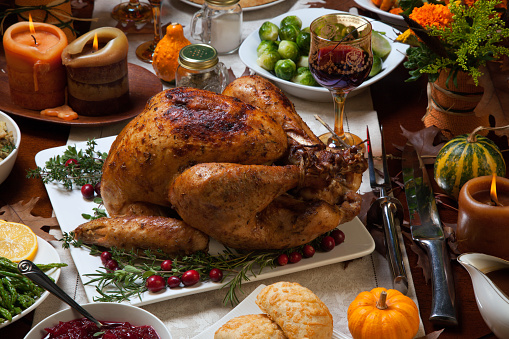You’ve probably heard about “holiday weight gain,” which happens in that dreaded period between Thanksgiving and New Year’s Day, when people expect to gain five to seven pounds. Even health professionals get in on the act. Many of my patients at the nutrition clinic at the Children’s Evaluation and Rehabilitation Center at Montefiore have come to see holiday weight gain as a done deal.
 Well, get ready to change your mind about gaining that much weight. Research in recent years has shed new light on presumed holiday weight gain. Even though some individuals have reported weight increases of 5 to 10 pounds during the holidays, research on large groups of people doesn’t really bear this out as a widespread phenomenon.
Well, get ready to change your mind about gaining that much weight. Research in recent years has shed new light on presumed holiday weight gain. Even though some individuals have reported weight increases of 5 to 10 pounds during the holidays, research on large groups of people doesn’t really bear this out as a widespread phenomenon.
One study conducted by the National Institutes of Health (NIH)―following mostly NIH employees―found that the average weight gain was only one pound. Granted, NIH employees may be more health conscious than the average person, but a 2014 look at research on holiday weight gain found startlingly minimal weight increases during the holiday period. Among the six studies published between 2006 and 2013 that looked at the subject, the average weight gain was just below two pounds. A few studies found no significant weight gain.
Who is at risk for holiday weight gain?
This doesn’t mean that a person can’t gain weight during the holidays—only that people shouldn’t assume that it’s inevitable. These studies put individual results into a statistical blender and come up with an average, and there was a wide range of individual weight changes. Significantly, people who were already overweight or obese were most likely to experience the largest weight gain.
Research aside, I’m most concerned with the weight of each individual patient who visits my office. Since these studies found greater holiday weight gain among overweight and obese people than among normal-weight people, the former require more attention at the onset of the holiday season.
To start, I look at the patients’ weight histories, their stress levels about holidays, and their comfort levels with holiday food and eating. Are they comfortable in social gatherings or do they use them as “exceptions” that give them permission to throw caution to the wind? Are they eating so they won’t offend particular relatives who made dishes “just for them”? Is the problem that there is just so much tempting food to take home or that’s left after parties?
Managing holiday meals
Children are home a lot more during the holidays, and high-calorie food is more accessible to them, so they’re a special concern. It’s best to keep to their regular schedule of meals and snacks and above all, get them moving with things they like doing, preferably outside the home. Kids, like many adults, eat more when they’re bored, and during holidays at home they can be bored out of their minds—always a dangerous thing.
I emphasize that being physically active during the holidays is a must. We’re busy during holidays, but busy doesn’t always mean physically active. That extra hour or two we need to buy gifts or run errands is likely to come right out of gym time. People are also fatigued by the holidays, so morning walks can be the first casualties when more sleep is needed.
Ironically, the holidays are exactly when being physically active is most necessary. More than just a calorie-burner, physical activity is a stress-buster and a mood-lifter. There’s a lot of pressure to feel upbeat and happy during the holiday period, but it’s also one of the most stressful times of the year for many people. Family issues can surface and emotions can make people hypersensitive. When anyone, especially the overweight and obese, get stressed, eating can be the quick fix they turn to, with unfortunate results come January 1.
Social gatherings require strategic planning. Holiday eating doesn’t call for abstinence from favorite foods. It does require being more conscious of what, when, and how we’re eating and how we may be sabotaging ourselves. It’s okay to be the last one to reach the buffet table, and it’s okay to focus on the social aspect of the season. That’s why I suggest my “Rule of One”: Give yourself a single portion (one scoop, one piece) of each food you like and then move on. As for portion sizes, I tell patients to eat a “hospital-sized” portion; they know exactly what I mean. I also suggest eating more slowly, which allows them to savor their meals while feeling as if they’re eating more.
Finally, it’s good sometimes to redefine the goal. For an overweight or obese person, especially one with a strong history of holiday weight gain, just getting to January 1 without any weight gain is an accomplishment. When these people reach that goal, we all need to become their biggest cheerleaders.


Comments on this entry are closed.
Great points here. Unfortunately a lot of great foods this time of year aren’t the most healthy in the world! Moderation and continuing to exercise is the key to keeping yourself healthy.